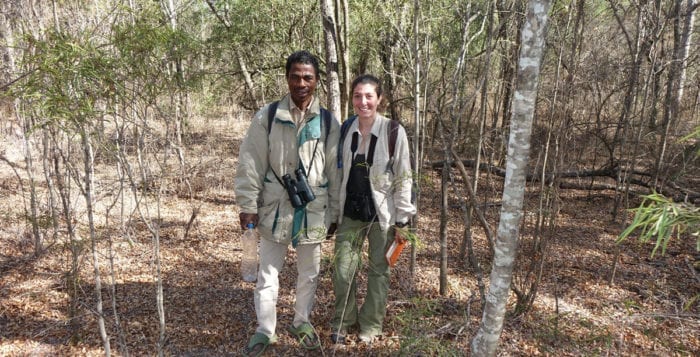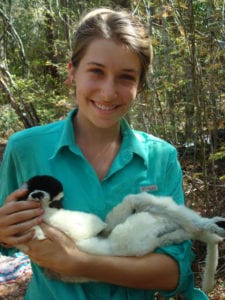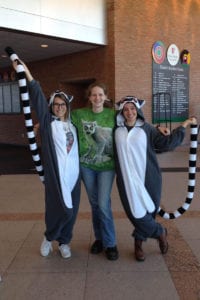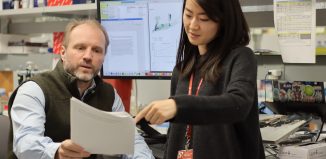SBU’s lemur work extends to cows, wheelbarrows and radios

For the last 25 years, Patricia Wright has traveled back and forth from Stony Brook to Madagascar, studying the island nation’s lemurs. Along the way, she has worn numerous hats.
Within a day of returning recently to Madagascar, a country that honored her with three Legion of Honor medals, Wright received a letter from a mayor who made an unusual request. He wrote to her explaining that “You’ve been talking about trash for a long time,” related Wright, who is a distinguished service professor in the Department of Anthropology at Stony Brook University and the director of the Institute for the Conservation of Tropical Environments.
He promised to help arrange for its pick up and removal “if you buy us three wheelbarrows.” She wrote back indicating that she’d purchase two wheelbarrows if he bought the last one.
Living and conducting research in Madagascar, other countries around the world or in the United States requires a vast array of skill sets, including negotiation, Wright said.
Indeed, Wright spoke with a scientific colleague she’s known from her work with spiders in Madagascar, Sarah Kariko, recently about a one-day training session Wright’s graduate students could attend at Harvard, so they could learn to work with people with different agendas.

“Having to learn the negotiation fields on your feet is very difficult,” Wright said via Skype from Madagascar. “If you have a skill set you can draw on, you could deal with many of these situations so much easier.”
Kariko, who is a research director at Gossamer Labs and an associate in the Department of Organismic and Evolutionary Biology at Harvard University, and Gillien Todd, a lecturer on law at Harvard helped lead the training.
The goal of the seminar, Kariko explained, was to teach negotiation skills through role playing, games, lectures, discussion and case studies that participants, which included undergraduates and graduate students from Harvard, among others, could apply to their own life and work.
Wright’s graduate students appreciated the opportunity to hear and consider different scenarios that might require negotiation.
Katherine Kling recently started her Ph.D. in Wright’s lab. She studies lemurs that live in nontraditional environments including rice paddies and farms. “Crossover disciplinary training is important,” Kling said. “We’re not just doing science. We need to consider negotiating techniques.”
Kling is developing a conservation radio program in Madagascar. Every episode will focus on one of the lemur species in the country. To build interest in the stories, she hopes to involve music and musicians and stories from children and researchers.
“Who doesn’t want to listen to the radio?” Kling asked. “We’re hoping to make programs about lemurs, conservation and the environment that are interesting and fun.”
Kling “hopes to inspire people to care and know they can” achieve conservation goals on their own, she suggested.
In her research, Kling hopes to gain a better understanding of why lemurs are moving into these so-called matrix environments. She would like to see how humans altering a landscape affect lemur behavior.
Kling graduated from college in 2013 and took two years off before starting her Ph.D. The anthropologist developed and honed several important skills outside the realm of scientific research, as she worked at Disney World’s Animal Kingdom Theme Park in Florida.
Kling described the experience as “awesome” and explained that she “wanted to learn how people respond to conservation.” She appreciated the chance to work with children and help them forge a connection with animals at the theme park and carried over the skills and approach she used at work into everyday parts of her life.
“We were trained to talk to anyone we saw in the park,” she recalled. She’d go to the grocery store and would “talk to everyone there. You can’t turn yourself off.”

Gena Sbeglia, another Ph.D. student in Wright’s lab who is studying how social behavioral patterns affect disease transmission, suggested that people often feel negotiation starts with conflicts, which isn’t always the case.“There can be a mutual movement towards a good,” Sbeglia said.
Negotiations are a part of the research and life experience for scientists that extend well beyond the realm of their scientific mission.
Sbeglia said she was preparing to do field work in the Tsaranoro Valley and wanted to put identifying colors on ring-tailed lemurs. Any research needs the approval of the local kings. She had already received approval for her work in the forest, but no researcher had put collars on the lemurs before.
She understood that it would be difficult to get permission because the animals are considered sacred. With her guide as an intermediary, she explained how she would bring an experienced darting team that included a vet and that she intended to study these lemurs for a year. Other scientists would also be able to conduct their own field work if they could track and monitor individual animals.
Sbeglia received permission, although she didn’t put collars on the lemurs because the logistics of the site were inappropriate for her research.
Wright suggested that discussions in the conservation world can lead to creative solutions. When she was working to establish Ranomafana National Park, Wright hired Professor Beth Middleton, an expert on cattle damage in rainforests, to determine the effect of the cows on the park. Her work showed that for the population of cattle in the park at the time, the negative impact on the forest was minimal. The village elders had kept the cattle there to protect them from cattle rustlers.
“The elders agreed not to put more cattle in the park,” which was a satisfying solution for the scientists, Wright recounted. “By allowing the cattle to stay inside the forest, it showed that negotiation works both ways, so that both sides can win.”






